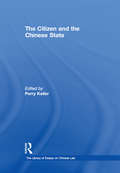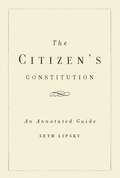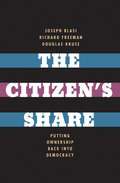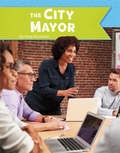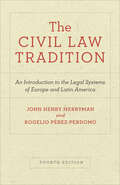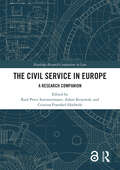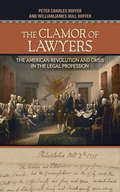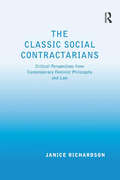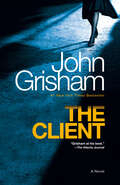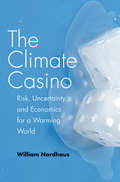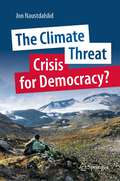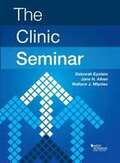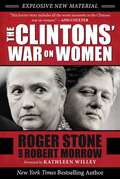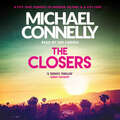- Table View
- List View
The Citizen and the Chinese State (The Library of Essays on Chinese Law)
by Perry KellerThis volume addresses several core questions regarding the nature of law in China and its future development. In particular, these articles shed light on whether the rule of law ideal is commensurable with government based on the Chinese Communist Party. Beginning virtually from scratch, China has established a comprehensive legal system that boasts a constitution, primary and secondary legislation and plentiful regulations covering most areas of public and private life. Yet, as these articles discuss, its courts are enmeshed in Party and state hierarchies and are not empowered to directly apply constitutional principles or rights, ensuring that the law is subordinate to national public policy goals. Legal and extra-legal methods for punishing wrongdoing and resolving disputes also raise questions of due process of law. Ultimately, the question is therefore whether China's legal system, if eschewing formalised human rights, is developing a capacity to protect fundamental human dignity.
The Citizen's Constitution
by Seth LipskyAn Elements of Style for how our government is supposed to work
The Citizen's Share
by Douglas L. Kruse Richard B. Freeman Joseph R. BlasiThe idea of workers owning the businesses where they work is not new. In America's early years, Washington, Adams, Jefferson, and Madison believed that the best economic plan for the Republic was for citizens to have some ownership stake in the land, which was the main form of productive capital. This book traces the development of that share idea in American history and brings its message to today's economy, where business capital has replaced land as the source of wealth creation. Based on a ten-year study of profit sharing and employee ownership at small and large corporations, this important and insightful work makes the case that the Founders' original vision of sharing ownership and profits offers a viable path toward restoring the middle class. Blasi, Freeman, and Kruse show that an ownership stake in a corporation inspires and increases worker loyalty, productivity, and innovation. Their book offers history-, economics-, and evidence-based policy ideas at their best.
The City Mayor (U.S. Government)
by Amy KortuemWhat does a city mayor do? Learn about the duties of a city mayor and how the mayor serves people in the city. Descriptive main text, full-color photos, fast facts, and callout definitions work together to support understanding.
The Civil Contract of Photography
by Ariella AzoulayIn this groundbreaking work, Ariella Azoulay thoroughly revises our understanding of the ethical status of photography. It must, she insists, be understood in its inseparability from the many catastrophes of recent history. She argues that photography is a particular set of relations between individuals and the powers that govern them and, at the same time, a form of relations among equals that constrains that power. Anyone, even a stateless person, who addresses others through photographs or occupies the position of a photograph’s addressee, is or can become a member of the citizenry of photography.The crucial arguments of the book concern two groups that have been rendered invisible by their state of exception: the Palestinian noncitizens of Israel and women in Western societies. Azoulay’s leading question is: Under what legal, political, or cultural conditions does it become possible to see and show disaster that befalls those with flawed citizenship in a state of exception? The Civil Contract of Photography is an essential work for anyone seeking to understand the disasters of recent history and the consequences of how they and their victims are represented.
The Civil Law Tradition: An Introduction to the Legal Systems of Europe and Latin America, Fourth Edition
by John Henry Merryman Rogelio Pérez-PerdomoDesigned for the general reader and students of law, this is a concise history and analysis of the civil law tradition, which is dominant in most of Europe, all of Latin America, and many parts of Asia, Africa, and the Middle East. The fourth edition is fully updated to include the latest developments in the field and to correct and update historical details gleaned from newly-published research on Roman and Medieval law. In the past ten years, the legal profession has changed radically, with the growing international ubiquity of large law firms operating across borders (which was previously a uniquely American phenomenon). This new edition updates the book from the post-Soviet era to ongoing current issues, including Brexit and the status of the European Union. It discusses how civil law codes have shifted in some countries to adapt to modern and changing ideologies and also includes brand-new material on legal education, which is of central importance to the legal profession today.
The Civil Service in Europe: A Research Companion (Routledge Research Companions in Law)
by Karl-Peter Sommermann Cristina Fraenkel-Haeberle Adam KrzywońThis book opens an often nationally focused field of research to a transnational, common European debate. It addresses the ongoing transformation of the civil service, examining its evolving landscape across Europe and exploring the intricate web of historical, social, and political influences that are shaping its current state and setting the future direction. Written by experts from different European countries, this book offers a transnational and interdisciplinary perspective on the civil service by combining legal analysis with insights from public management, political science, and sociology. It addresses the growing complexity of public administration tasks and the increasing requirements related to the qualification of civil servants, amidst global challenges such as climate change, migration, and technological progress. The book is structured to provide both a broad overview as well as in-depth analyses. It covers national developments, presents comparative studies, and tackles intersecting issues such as employment systems, non-discrimination and human rights, digitalisation, artificial intelligence, the fight against corruption, and administrative culture. It aims to identify common European standards and provide practical guidance for public service reforms. The volume will prove to be an indispensable resource for academics, practitioners, and policymakers concerned with public administration and governance.The Open Access version of this book, available at http://www.taylorfrancis.com, has been made available under a Creative Commons Attribution-Non Commercial-No Derivatives (CC-BY-NC-ND) 4.0 license.
The Clamor of Lawyers: The American Revolution and Crisis in the Legal Profession
by Peter Charles Hoffer Williamjames Hull HofferThe Clamor of Lawyers explores a series of extended public pronouncements that British North American colonial lawyers crafted between 1761 and 1776. Most, though not all, were composed outside of the courtroom and detached from on-going litigation. While they have been studied as political theory, these writings and speeches are rarely viewed as the work of active lawyers, despite the fact that key protagonists in the story of American independence were members of the bar with extensive practices. The American Revolution was, in fact, a lawyers’ revolution.Peter Charles Hoffer and Williamjames Hull Hoffer broaden our understanding of the role that lawyers played in framing and resolving the British imperial crisis. The revolutionary lawyers, including John Adams’s idol James Otis, Jr., Pennsylvania’s John Dickinson, and Virginians Thomas Jefferson and Patrick Henry, along with Adams and others, deployed the skills of their profession to further the public welfare in challenging times. They were the framers of the American Revolution and the governments that followed. Loyalist lawyers and lawyers for the crown also participated in this public discourse, but because they lost out in the end, their arguments are often slighted or ignored in popular accounts. This division within the colonial legal profession is central to understanding the American Republic that resulted from the Revolution.
The Clash of Capitalisms?: Chinese Companies In The United States
by Ji LiChinese foreign direct investment in the United States has generated intense debates. Some welcome it for the immediate benefits such as job creation; others view Chinese investments, especially those controlled by the Chinese government, as a critical threat. The debates have so far missed an important question: how do Chinese companies investing in the US react to the host country's law? <P><P>Ji Li formulates a novel analytical framework to examine the adaptation of Chinese companies to general US institutions and their compliance with US laws governing tax, employment equality, and national security review of foreign investments. The level of compliance varies, and this variation is examined in relation to company ownership, including state ownership. Li's analysis is based on interviews and a unique and comprehensive dataset about Chinese companies in the United States that has never been systematically explored.<P> Proposes a new analytical framework for researching foreign investors' compliance with host country law.<P> Draws on a unique dataset covering almost all the largest Chinese companies in the US.<P> Combines qualitative and quantitative analysis.<P>
The Classic Social Contractarians: Critical Perspectives from Contemporary Feminist Philosophy and Law
by Janice RichardsonHow can we live together without subordination and oppression? What does it mean to treat each other as free and equal persons? This book uses contemporary feminist insights to examine aspects of the classic social contractarians' arguments, focusing specifically upon the work of Hobbes, Spinoza, Locke, Rousseau and Kant. Considering the relationship between the 'self' and the law, this volume also looks at the points at issue between feminist political theorists and considers the usefulness of contractarian arguments for feminist politics today, together with an examination of the relationship between their political, legal and moral analyses.
The Classical Liberal Constitution: The Uncertain Quest for Limited Government
by Richard A. EpsteinAmerican liberals and conservatives alike take for granted a progressive view of the Constitution that took root in the early twentieth century. Richard Epstein laments this complacency which, he believes, explains America's current economic malaise and political gridlock. Steering clear of well-worn debates between defenders of originalism and proponents of a living Constitution, Epstein employs close textual reading, historical analysis, and political and economic theory to urge a return to the classical liberal theory of governance that animated the framers' original constitutional design. Grounded in the thought of Locke, Hume, Madison, and other Enlightenment figures, classical liberalism emphasized federalism, restricted government, separation of powers, and strong protection of individual rights. New Deal progressives challenged this synthesis by embracing government as a force for social good rather than a necessary evil. The Supreme Court has unwisely ratified the progressive program by sustaining many legislative initiatives at odds with the classical liberal Constitution. Epstein addresses both the Constitution's structural safeguards against state power and its protection of individual rights. He sheds light on contemporary disputes ranging from presidential prerogatives to health care legislation, while exploring such enduring topics as judicial review, economic regulation, freedom of speech and religion, and equal protection.
The Classical Utilitarians
by John Stuart Mill Jeremy Bentham John TroyerThis volume includes the complete texts of two of John Stuart Mill's most important works, Utilitarianism and On Liberty, and selections from his other writings, including the complete text of his Remarks on Bentham's Philosophy. The selection from Mill's A System of Logic is of special relevance to the debate between those who read Mill as an Act-Utilitarian and those who interpret him as a Rule-Utilitarian.Also included are selections from the writings of Jeremy Bentham, founder of modern Utilitarianism and mentor (together with James Mill) of John Stuart Mill. Bentham's Principles of Morals and Legislation had important effects on political and legal reform in his own time and continues to provide insights for political theorists and philosophers of law. Seven chapters of Bentham's Principles are here in their entirety, together with a number of shorter selections, including one in which Bentham repudiates the slogan often used to characterize his philosophy: The Greatest Happiness of the Greatest Number.John Troyer's Introduction presents the central themes and arguments of Bentham and Mill and assesses their relevance to current discussions of Utilitarianism. The volume also provides indexes, a glossary, and notes.
The Clean Water Act 20 Years Later
by Robert W. Adler Diane M. Cameron Jessica C. LandmanThis volume explores the issues associated with the complex subject of water quality protection in an assessment of the successes and failures of the Clean Water Act over the past twenty years. In addition to examining traditional indicators of water quality, the authors consider how health concerns of the public have been addressed, and present a detailed examination of the ecological health of our waters. Taken together, these measures present a far more complete and balanced picture than raw water quality data alone.As well as reviewing past effectiveness, the book includes specific recommendations for the reauthorization of the Act, which is to be considered by Congress in 1995. This balanced and insightful account will surely shape the debate among legislative and policy experts and citizen activists at all levels who are concerned with issues of water quality.
The Client: A Novel (Penguin Joint Venture Readers Ser.penguin Readers Series)
by John Grisham#1 NEW YORK TIMES BESTSELLER • A white-knuckle legal thriller that begins in a weedy lot on the outskirts of Memphis, when two boys watch a shiny Lincoln pull up to the curb. . . . &“The desire to find out what happens next keeps the reader turning the pages. Grisham is an absolute master of the chase story.&”—The Washington PostEleven-year-old Mark Sway and his younger brother were sharing a forbidden cigarette when a chance encounter with a suicidal lawyer left Mark knowing a bloody and explosive secret: the whereabouts of the most sought-after dead body in America. Now Mark is caught between a legal system gone mad and a mob killer desperate to cover up his crime. And his only ally is a woman named Reggie Love, who has been a lawyer for all of four years. Prosecutors are willing to break all the rules to make Mark talk. The mob will stop at nothing to keep him quiet. And Reggie will do anything to protect her client—even take a last, desperate gamble that could win Mark his freedom . . . or cost them both their lives.
The Cliff House Strangler: A Sarah Woolson Mystery (Sarah Woolson Mysteries #3)
by Shirley TallmanNineteenth-century attorney Sarah Woolson is still trying to get her life together. Against her family's wishes, she opens her own San Francisco law firm, only to find that clients---paying clients, that is---are wary of allowing a woman to manage their legal affairs. Just when her patience, as well as her money, are about to run out, Sarah and her friend and former colleague, Robert Campbell, attend a séance at San Francisco's Cliff House. Making their way through the worst storm of the season, they arrive at their destination to find themselves in for much more than, in Robert's words, "silly parlor tricks." After a dramatic display of spirit apparitions, flying trumpets, and phantom music, Madame Olga Karpova---a renowned Russian clairvoyant---and her guests make a grisly discovery: One of the twelve people seated at the table has been brutally strangled.Later, when two more séance participants are found slain, Sarah is pressed into defending the accused murderer. Working on her client's case, she quickly finds herself at the center of a complicated murder plot involving ghosts, gypsies, and City Hall, all the while facing off with Robert in a volatile legal battle and investigating her brother Frederick's shady political dealings. Hardly proper behavior for a nineteenth-century woman, but Sarah wouldn't have it any other way.Feisty and determined, Sarah continues to flout the notions of "proper" femininity in this series that is a turn-of-the-century answer to Legally Blonde.
The Climate Casino
by William D. NordhausClimate change is profoundly altering our world in ways that pose major risks to human societies and natural systems. We have entered the Climate Casino and are rolling the global-warming dice, warns economist William Nordhaus. But there is still time to turn around and walk back out of the casino, and in this essential book the author explains how. Bringing together all the important issues surrounding the climate debate, Nordhaus describes the science, economics, and politics involved--and the steps necessary to reduce the perils of global warming. Using language accessible to any concerned citizen and taking care to present different points of view fairly, he discusses the problem from start to finish: from the beginning, where warming originates in our personal energy use, to the end, where societies employ regulations or taxes or subsidies to slow the emissions of gases responsible for climate change. Nordhaus offers a new analysis of why earlier policies, such as the Kyoto Protocol, failed to slow carbon dioxide emissions, how new approaches can succeed, and which policy tools will most effectively reduce emissions. In short, he clarifies a defining problem of our times and lays out the next critical steps for slowing the trajectory of global warming.
The Climate Threat. Crisis for Democracy?
by Jon NaustdalslidA key point in the book is the need to focus more seriously at the energy problem as the real problem behind global warming. The failure of global climate policies to reduce CO2 emissions and halt climate change has led an increasing number of scientist and activists to lose confidence in democracy's ability to handle climate change and led them to look to more authoritarian measures to meet the problem. The book documents these trends, also from a historical perspective, criticize them and sketches more democratic alternatives.
The Climate-Conflict-Displacement Nexus from a Human Security Perspective
by Mohamed Behnassi Himangana Gupta Fred Kruidbos Anita ParlowClimate change is reshaping the planet, its ecosystems, and the evolution of human societies. Related impacts and disasters are triggering significant shifts in the inextricably interconnected human and ecological systems with unprecedented potential implications. These shifts not only threaten survival at species and community levels, but are also emerging drivers of conflicts, human insecurity, and displacement both within and across national borders. Taking these shifting dynamics into account, particularly in the Anthropocene era, this book provides an analysis of the climate-conflict-migration nexus from human security and resilience perspectives. The core approach of the volume consists of unpacking the key dynamics of the nexus between climate change, conflict, and displacement and exploring the various local and global response mechanisms to address the nexus, assess their effectiveness, and identify their implications for the nexus itself. It includes both conceptual research and empirical studies reporting lessons learned from many geographical, environmental, social, and policy settings.
The Climate-Smart Agriculture Papers: Investigating the Business of a Productive, Resilient and Low Emission Future
by Todd S. Rosenstock Andreea Nowak Evan GirvetzThis book is open access under a CC BY 4.0 license.This volume shares new data relating to Climate-Smart Agriculture (CSA), with emphasis on experiences in Eastern and Southern Africa. The book is a collection of research by authors from over 30 institutions, spanning the public and private sectors, with specific knowledge on agricultural development in the region discussed. The material is assembled to answer key questions on the following five topic areas: (1) Climate impacts: What are the most significant current and near future climate risks undermining smallholder livelihoods? (2) Varieties: How can climate-smart varieties be delivered quickly and cost-effectively to smallholders? (3) Farm management: What are key lessons on the contributions from soil and water management to climate risk reduction and how should interventions be prioritized? (4) Value chains: How can climate risks to supply and value chains be reduced? and (5) Scaling up: How can most promising climate risks reduction strategies be quickly scaled up and what are critical success factors? Readers who will be interested in this book include students, policy makers, and researchers studying climate change impacts on agriculture and agricultural sustainability.
The Clinic Seminar: The Student Edition
by Deborah Epstein Jane AikenThe Clinic Seminar provides a fully developed seminar curriculum for use in any clinic, regardless of subject matter, by any teacher, regardless of experience level. Together, the student text and teacher guide provide a full syllabus of 20 model classes designed for two-hour class sessions, with step-by-step instructions so that even a first-time clinician can enter the classroom with complete confidence. Topics in The Clinic Seminar including: Client Counseling, Communication and Assumptions, Interviewing, Project Interviewing, Informal Fact Investigation, Storytelling, Theory of the Case or Project, Collaboration, Direct Examination, Cross Examination, Exhibits, Objections, Opening Statements and Closing Arguments, Negotiation, Presentation Skills, Writing, Establishing Professional Boundaries, Conducting Rounds, Ethics, Challenging Assumptions, System Change, and Exploring Justice. .
The Clinical Interview of the Child
by Stanley I. Greenspan Nancy Thorndike GreenspanIdeal for both novices and advanced practitioners, the new edition of Stanley Greenspan's classic guide outlines a practical process for observing and interviewing children -- and organizing and interpreting their unfolding communications. The third edition has been expanded and revised extensively, with updated theoretical and conceptual foundations; information on higher levels of ego development and reflective and thinking capacities of older children; and a new section on a developmental biopsychosocial model -- the developmental, individual-difference, relationship-based (DIR) approach. An invaluable educational and practical resource, The Clinical Interview of the Child, Third Edition, is an ideal tool for psychiatrists and psychologists, pediatricians, educators, social workers, speech pathologists, occupational therapists, and judges and attorneys dealing with children and families.
The Clintons' War on Women
by Robert Morrow Roger Stone"This book on Hillary - really tough." - President Donald TrumpHillary Clinton is running for president as an "advocate of women and girls,” but there is another shocking side to her story that has been carefully covered up-until now. This stunning exposé reveals for the first time how Bill and Hillary Clinton systematically abused women and others-sexually, physically, and psychologically-in their scramble for power and wealth.In this groundbreaking book, New York Times bestselling author Roger Stone and researcher and alternative historian Robert Morrow map the arc of Bill and Hillary’s crimes and cover-ups. They reveal details about their actions in Arkansas, during Bill Clinton’s time in the White House, about who really ordered the deadly attack on the Branch Davidian compound in Waco, during Hillary’s tenure as secretary of state, about their time at the Clinton Foundation, and during Hillary’s current campaign for president.This is the first book to shed light on the couple’s deeply personal violations of the people they crushed in their obsessive quest for power. Along the way, Stone and Morrow reveal the family’s darkest secrets, including a Clinton family member’s drug rehab treatment that was never reported by the press, Hillary Clinton’s unusually close relationship with a top female aide, and a stunning revelation of such impact that it could strip Bill Clinton of his current popularity and derail Hillary’s push to be the second Clinton in the White House.Anyone who cares about the future of the United States will want to read this tell-all, exposing the appalling, unvarnished, and ugly truth about the Clintons. This paperback edition includes a new preface from Roger Stone, revealing explosive new information he’s learned since the hardcover’s release.
The Close Relationship between Nietzsche's Two Most Important Books
by T. H. BrobjerThis book studies the close relationship between Thus Spoke Zarathustra and the unfinished four volume Revaluation of All Values that he worked on until shortly before his collapse. It is unlikely that he would have returned to and continued Thus Spoke Zarathustra, but he considered publishing the fourth part (which had not yet been published) as a bridge between Zarathustra and the unfinished Revaluation of All Values. More importantly, during his last years he worked hard on revaluing values, often in line with what he had written in Thus Spoke Zarathustra. This present study performs detailed analyses of Nietzsche’s texts and late notes to examine the direction of that unfinished work; it will function as a stimulus to further research on the direction, interpretation and consequences of Nietzsche’s late thought.
The Closers (Harry Bosch Series #11)
by Michael ConnellyHarry is back, assigned to the LAPD's Open-Unsolved Unit with his former cop ally and partner, Kizmin Rider. These detectives are the Closers. They are thrown into a politically sensitive and dangerous case when a white supremacist is connected to the 1988 murder of a mixed race girl. The police department has changed, but one thing hasn't - Harry's nemesis, Irving. The former Deputy Chief has been pushed from power and given a virtually meaningless new role. Full of vengeance, Irving calls Harry a 'retread'. He watches from the sidelines like an injured bear, hoping Harry will make a mistake...Read by Len Cariou(p) 2005 Hachette Audio
The Closers (Harry Bosch Series #11)
by Michael ConnellyAfter three years as a PI, Harry Bosch returns to the LAPD. The superb page-turning eleventh Bosch novel from the award-winning No. 1 bestselling author. Harry is back, assigned to the LAPD's Open-Unsolved Unit with his former cop ally and partner, Kizmin Rider. These detectives are the Closers. They are thrown into a politically sensitive and dangerous case when a white supremacist is connected to the 1988 murder of a mixed race girl. The police department has changed, but one thing hasn't - Harry's nemesis, Irving. The former Deputy Chief has been pushed from power and given a virtually meaningless new role. Full of vengeance, Irving calls Harry a 'retread'. He watches from the sidelines like an injured bear, hoping Harry will make a mistake . . .
